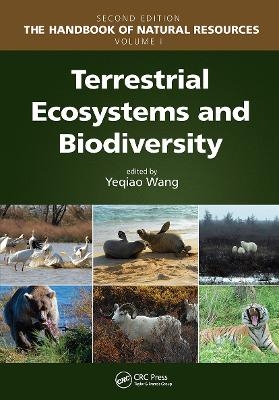
Terrestrial Ecosystems and Biodiversity
CRC Press (Verlag)
978-1-032-47442-7 (ISBN)
Authored by world-class scientists and scholars, The Handbook of Natural Resources, Second Edition, is an excellent reference for understanding the consequences of changing natural resources to the degradation of ecological integrity and the sustainability of life. Based on the content of the bestselling and CHOICE-awarded Encyclopedia of Natural Resources, this new edition demonstrates the major challenges that the society is facing for the sustainability of all well-being on the planet Earth. The experience, evidence, methods, and models used in studying natural resources are presented in six stand-alone volumes, arranged along the main systems of land, water, and air. It reviews state-of-the-art knowledge, highlights advances made in different areas, and provides guidance for the appropriate use of remote sensing and geospatial data with field-based measurements in the study of natural resources.
Volume 1, Terrestrial Ecosystems and Biodiversity, provides fundamental information on terrestrial ecosystems, approaches to monitoring, and impacts of climate change on natural vegetation and forests. New to this edition are discussions on biodiversity conservation, gross and net primary production, soil microbiology, land surface phenology, and decision support systems. This volume demonstrates the key processes, methods, and models used through many case studies from around the world.
Written in an easy-to-reference manner, The Handbook of Natural Resources, Second Edition, as individual volumes or as a complete set, is an essential reading for anyone looking for a deeper understanding of the science and management of natural resources. Public and private libraries, educational and research institutions, scientists, scholars, and resource managers will benefit enormously from this set. Individual volumes and chapters can also be used in a wide variety of both graduate and undergraduate courses in environmental science and natural science at different levels and disciplines, such as biology, geography, earth system science, and ecology.
Dr. Yeqiao Wang is a professor at the Department of Natural Resources Science, College of the Environment and Life Sciences, University of Rhode Island. He earned an MS and a PhD in natural resources management & engineering from the University of Connecticut. From 1995 to 1999, he was an assistant professor in the Department of Geography and Department of Anthropology, University of Illinois at Chicago. He has been on the faculty of the University of Rhode Island since 1999. In addition to his tenured position, he held an adjunct research associate position at the Field Museum of Natural History in Chicago. He has also served as a guest professor and an adjunct professor at universities in the U.S. and China. Among his awards and recognitions, Dr. Wang was awarded the prestigious Presidential Early Career Award for Scientists and Engineers (PECASE) by former U.S. President Clinton in 2000. His research projects have been funded by multiple agencies such as NASA, USDA, USDI, USAID, among others, which supported his scientific studies in various regions of the U.S., in East and West Africa, and in various regions in China. Besides peer-reviewed journal publications, Dr. Wang edited Remote Sensing of Coastal Environments and Remote Sensing of Protected Lands published by CRC Press in 2009 and 2010, respectively. He has also authored and edited over 10 scientific books in Chinese.
Section I: Biodiversity and Conservation 1. Assessment of Community-Based Activities to Reduce Human–Elephant Conflict in Nepal 2. Biodiversity: Agriculture 3. Biodiversity: Climate Change 4. Biodiversity: Conservation 5. Biodiversity: Habitat Suitability 6. Biodiversity: Tropical Agroforestry 7. Biodiversity: Values 8. Biomes 9. Decision-Making and Monitoring Strategies in Natural Resource Management and Conservation 10. Diversity: Species 11. Exotic and Invasive Species 12. Keystone and Indicator Species 13. Population Genetics 14. Prioritizing Conservation Sites for Biodiversity Protection in Uganda 15. Weeds: Seed Banks and Seed Dormancy Section II: Ecosystem Type, Function, and Service 16. Community Forestry: Sustainability and Equity Issues 17. Ecosystem Services: Evaluation 18. Ecosystem Services: Land Systems Approach 19. Ecosystem Services: Pollinators and Pollination 20. Ecosystems: Diversity 21. Ecosystems: Forest Nutrient Cycling 22. Ecosystems: Functions and Services 23. Ecosystems: Soil Animal Functioning 24. Ecotone 25. Environmental Goods and Services: Economic and Non-Economic Methods for Valuing 26. Forests: Temperate Evergreen and Deciduous 27. Forests: Tropical Rain 28. Savannas and Grasslands Section III: Ecological Processes 29. Agriculture: Organic 30. Crops and the Atmosphere: Trace Gas Exchanges 31. Desertification 32. Ecological and Evolutionary Processes 33. Ecology: Functions, Patterns, and Evolution 34. Land Plants: Origin and Evolution 35. Leaves: Elevated CO2 Levels 36. Net Ecosystem Production (NEP) 37. Nitrogen Deposition and Deyeuxia angustifolia Encroachment in Alpine Tundra 38. Nitrogen Fixation: Biological 39. Ozone: Crop Yield and Quality Effects 40. Global Plant Breeding Section IV: Ecosystem Monitoring 41. Altitudinal Belts: Global Mountains, Patterns, and Mechanisms 42. Biodegradation and Bioremediation 43. Decision Support: Monitoring, Reporting, and Forecasting Ecological Conditions of Appalachian Trail 44. Estimation of Net Primary Production and Its Spatial and Temporal Variations in Northeast China: Remote Sensing 45. Optical Properties of Reflected Light from Leaves 46. Remote Sensing of CO2 Emissions from Wildfires
| Erscheinungsdatum | 10.01.2023 |
|---|---|
| Reihe/Serie | The Handbook of Natural Resources, Second Edition |
| Zusatzinfo | 16 Illustrations, color; 87 Illustrations, black and white |
| Verlagsort | London |
| Sprache | englisch |
| Maße | 178 x 254 mm |
| Gewicht | 376 g |
| Themenwelt | Naturwissenschaften ► Biologie ► Ökologie / Naturschutz |
| Naturwissenschaften ► Geowissenschaften ► Hydrologie / Ozeanografie | |
| Weitere Fachgebiete ► Land- / Forstwirtschaft / Fischerei | |
| ISBN-10 | 1-032-47442-4 / 1032474424 |
| ISBN-13 | 978-1-032-47442-7 / 9781032474427 |
| Zustand | Neuware |
| Haben Sie eine Frage zum Produkt? |
aus dem Bereich


